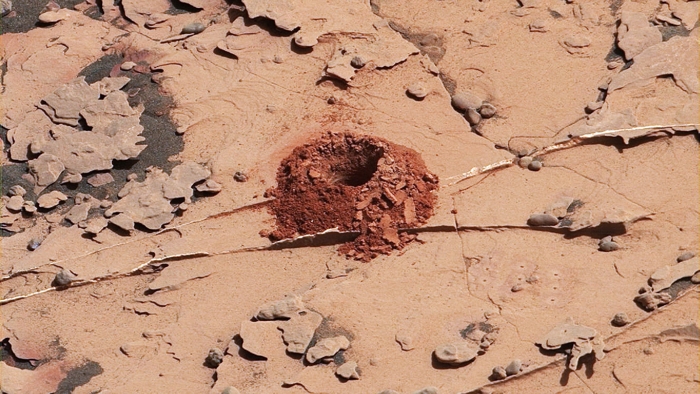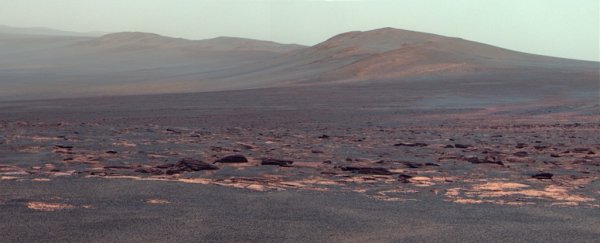The search for life on Mars may have just gotten a whole lot more complicated.
While rovers such as Curiosity and Perseverance scour the surface looking for traces of ancient life, new evidence reveals we may have to dig much deeper to find them. Any evidence of amino acids left over from a time when Mars may have been habitable are likely buried at least 2 meters (6.6 feet) under the ground.
That's because Mars, with its lack of magnetic field, and flimsy atmosphere, is subject to a much higher dose of cosmic radiation on its surface than Earth is. We know this, and we know that cosmic radiation destroys amino acids.
Now, thanks to experimental data, we also know that this process takes place on very short timescales, geologically speaking.
"Our results suggest that amino acids are destroyed by cosmic rays in the Martian surface rocks and regolith at much faster rates than previously thought," says physicist Alexander Pavlov of NASA's Goddard Space Flight Center.
"Current Mars rover missions drill down to about 2 inches (around 5 centimeters). At those depths, it would take only 20 million years to destroy amino acids completely. The addition of perchlorates and water increases the rate of amino acid destruction even further."
 A 2-inch-deep hole drilled by NASA's Curiosity rover. (NASA)
A 2-inch-deep hole drilled by NASA's Curiosity rover. (NASA)
Cosmic radiation is actually a huge concern for Mars exploration. An average human on Earth is exposed to about 0.33 millisieverts of cosmic radiation per year. On Mars, that annual exposure could be over 250 millisieverts.
This high-energy radiation, streaming from solar flares and energetic events such as supernovae, can penetrate rock, ionizing and destroying any organic molecules it encounters.
Once upon a time, Mars is thought to have had a global magnetic field, and a much thicker atmosphere, much like Earth. There's also evidence – lots of it – that liquid water once sat on the Martian surface in the form of oceans, rivers, and lakes.
This combination of features suggests that Mars could have been habitable (perhaps repeatedly) in its past.
One sign that could point to the habitability of Mars is the presence of amino acids. These organic compounds aren't biosignatures, but some of the most basic building blocks of life.
Amino acids combine to form proteins, and have been found in space rocks, such as asteroid Ryugu, and the atmosphere of Comet 67P. So they're not a definitive sign of life, but finding them on Mars would be another clue pointing to life's possible emergence there, once upon a time.
Pavlov and his team wanted to better understand the likelihood of finding evidence of amino acids on the Martian surface, so they designed an experiment to test the hardiness of these compounds.
They mixed amino acids with mineral mixes designed to simulate Mars soil, consisting of silica, hydrated silica, or silica and perchlorates (salts), and sealed them in test tubes mimicking the Martian atmosphere, at a variety of Mars-like temperatures.
Then, the team irradiated the samples with ionizing gamma radiation, to mimic the dose of cosmic radiation expected on Mars' surface over a period of about 80 million years. Previous experiments only blasted the amino acids, without the soil simulants. This may have given an inaccurate lifespan for the amino acids.
"Our work is the first comprehensive study where the destruction (radiolysis) of a broad range of amino acids was studied under a variety of Mars-relevant factors (temperature, water content, perchlorate abundance) and the rates of radiolysis were compared," Pavlov says.
"It turns out that the addition of silicates and particularly silicates with perchlorates greatly increases the destruction rates of amino acids."
That means that any amino acids on the Martian surface earlier than about 100 million years ago are probably long gone, irradiated into nothing.
Given that Mars' surface hasn't been hospitable to life as we know it for much longer than that – billions of years, rather than millions – the few centimeters that Curiosity and Perseverance can dig down to is unlikely to pony up amino acids.
Both the rovers have found organic material on Mars, but since the molecules could have been produced by non-biological processes, they can't be taken as evidence of life. In addition, the team's research shows that those molecules may have been significantly altered since their formation by ionizing radiation.
There's also other evidence to suggest that the research team might be onto something. Every now and again, material from below the Martian surface does actually make its way to Earth. In fact, amino acids have even been found therein.
"We did identify several straight-chain amino acids in the Antarctic Martian meteorite RBT 04262 in the Astrobiology Analytical Lab at Goddard that we believe originated on Mars (not contamination from terrestrial biology), although the mechanism of formation of these amino acids in RBT 04262 remains unclear," says astrobiologist Danny Glavin of NASA Goddard.
"Since meteorites from Mars typically get ejected from depths of at least 3.3 feet (1 meter) or more, it is possible that the amino acids in RBT 04262 were protected from cosmic radiation."
We might have to wait until we have more hardcore digging tools on Mars to find out more, though.
The research has been published in Astrobiology.
